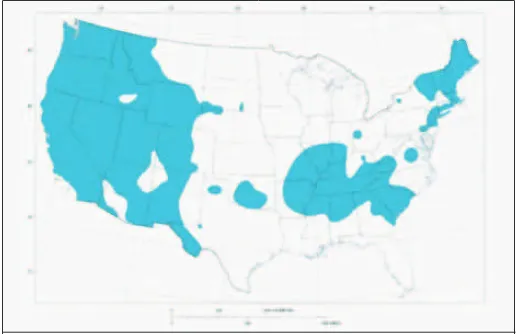Repor t
HigHligHts
State of the Art and Practice in Earthquake
Induced Soil Liquefaction Assessment
A
pproximately 40% of the United states is subject to ground mo-tions severe enough to cause certain saturated soils to lose their strength to the point where they may not be able to support the foundations of buildings and other infrastructure—a phenomenon known as liquefaction (see Figure 1, p. 2). those earthquake prone areas include san Fernando, California, where a 1971 earthquake triggered liq-uefaction that produced a landslide on the upstream face of the lower san Fernando Dam, leaving only about 5 feet of broken soil holding back approximately 15 million tons of water. Eighty thousand people were evacuated from the valley below. Had the reservoir had been at its maxi-mum level, or if the landslide had been a bit larger, it would have been the greatest earthquake-related disaster in U.s. history.the series of earthquakes that struck Christchurch, New Zealand
in 2010-2011 is a vivid example of the damage that can occur when soil liquefaction is triggered during an earthquake. Although the most damaging of the Christchurch earth-quakes had a relatively modest estimated magnitude of 6.2, more than 15,000 homes were lost and hundreds of buildings destroyed as a result of liquefaction.
these examples illustrate the importance of accurate assessments of where liquefac-tion is likely to occur and of what its consequences may be. such assessments are needed to protect life and safety and to mitigate economic, environmental, and societal impacts of liquefaction in a cost-effective manner.
WHAT IS LIQUEFACTION?
seismic shaking of suficient strength and duration can transform certain saturated soils (sands and some silts and gravels) into a suspension of soil particles and water that behaves like a viscous luid. impacts can include subsidence (sinking) and soil movement—effects that, in turn, can cause the collapse of buildings and bridges; disruption of roadways; the failure of earth-retaining structures; the cracking, sliding, and overtopping of dams and highway embankments; and ruptures of sewer, water, and fuel lines and other lifeline infrastructure.
WHY THIS REPORT?
the basis of the most commonly used method for liquefaction triggering assessment is an empirical stress-based approach irst developed in 1971. the procedure has evolved over the years as additional ield case histories were documented and laboratory and numerical studies improved the understanding of the mechanics of liquefaction. By 2004, however, reputable groups were suggesting alternative sets of changes to this method. since then, alternative approaches continued to be reined, and additional modiications have been suggested. Practitioners now must choose among multiple methods without
Liquefaction during the
2010–2011 earthquake
sequence in New Zealand
was so severe that more
than 15,000 homes were
lost and utilities and other
infrastructure required
major repairs.
December 2016
Copyright 2016 by the National Academy of Sciences. All rights reserved.
COMMITTEE ON STATE OF THE ART AND PRACTICE IN EARTHQUAKE INDUCED SOIL
LIQUEFACTION ASSESSMENT
Edward Kavazanjian, Jr. (Chair), Arizona state University, tempe; José E. Andrade, California institute of technology, Pasadena; Kandiah “Arul” Arulmoli, Earth Mechanics, inc., Fountain Valley, CA; Brian F. Atwater, U.s. geological survey and University of Washington, seattle; John T. Christian, independent Consultant, Burlington, MA; Russell Green, Virginia Polytechnic institute and state University, Blacksburg; Steven L. Kramer, University of Washington, seattle; Lelio Mejia, AECOM, Oakland, CA; James K. Mitchell, Virginia Polytechnic institute and state University (Retired), Blacksburg; Ellen Rathje, the University of texas at Austin; James R. Rice, Harvard University, Cambridge, MA; Yumei Wang, Oregon Department of geology and Mineral industries, Portland; Sammantha Magsino (Study Director), Courtney R. Gibbs (Program Associate) National Academies of sciences, Engineering, and Medicine.
Copyright 2016 by the National Academy of Sciences. All rights reserved.
Division on Earth and life studies
and Medicine was to objectively evaluate existing ield, laboratory, physical models, and analytical methods for assessing liquefaction and its consequences and to describe how to account for and reduce the uncertainties associated with the use of those methods.
RECOMMENDED ACTIONS
the study committee’s 11 recommendations to the research community and engineering practitioners touch on sev-eral broad themes. One theme is a call for greater use of principles from the ields of geology, seismology, and soil mechanics to improve the understanding of the likelihood and consequences of liquefaction. Explicit consideration of the uncertainties associated with the data on which assessment procedures are based, and hence the inherent uncertainty associated with the assessment procedures, also are needed. Another theme is a call to establish expanded, standardized, and publicly accessible databases of lique-faction case histories that could be used to develop and validate improved methods for assessing liquefaction and its consequences. in addition, observatories for gathering data before, during, and after an earthquake at sites with a high likelihood of liquefaction would allow better understanding of the processes of liquefaction, and potential consequences and ways to mitigate them.
necessarily understanding the uncertainties associated with their use. As a result, infrastructure design often incurs addi-tional costs to provide the desired conidence that the effects of liquefaction are properly mitigated. the purpose of this study by the National Academies of sciences, Engineering,
Figure 1. Map showing areas with the potential for ground shaking intense enough to cause liquefaction in water-saturated granular materials. Alaska and Hawaii are not shown, but those states also have extensive areas of liquefaction hazard. (liquefaction cannot be precluded in areas where not shaded, depending on site speciic condi-tions.) sOURCE: Usgs
